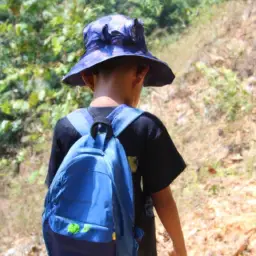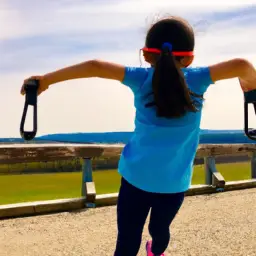Are you looking for ways to help your child succeed in school and in life? One important factor to consider is grit.
Grit is a term used to describe a combination of passion, perseverance, and resilience, and it is a key predictor of success in many areas of life. By teaching your child grit from an early age, you can help them develop the skills and mindset they need to overcome challenges and achieve their goals.
In this article, you will learn about the definition and importance of grit, as well as strategies for encouraging grit in children. You will also discover how grit impacts academic performance and the role that teachers and parents can play in teaching grit. Finally, we will discuss the importance of early childhood education in fostering the development of grit in young children.
By the end of this article, you will have a better understanding of the benefits of teaching grit in early childhood education and how you can help your child develop this important trait.
Key Takeaways
- Grit is a combination of passion, perseverance, and resilience that can be taught to children from an early age.
- Teaching grit can help children overcome challenges, improve academic performance, and achieve success in many areas of life.
- Strategies for encouraging grit in children include creating a growth mindset, providing opportunities for failure and success, and developing resilience and problem-solving skills.
- Essential skills and habits for developing grit include fostering a love of learning, promoting social emotional development, and balancing individual and group needs.
The Definition and Importance of Grit
You’ll find that understanding the definition and importance of grit is crucial for effectively instilling resilience and perseverance in young learners.
Grit is defined as the combination of passion, perseverance, and resilience towards long-term goals. It’s not just about working hard, but also about pushing through challenges and setbacks without giving up.
This is especially important for young learners as they face various obstacles in their academic and personal lives. Some of the characteristics of grit include having a growth mindset, being able to delay gratification, and being resilient in the face of failure.
By teaching children about grit, educators can help them develop these important skills early on. When students understand that their effort and perseverance can lead to success, they’re more likely to work harder and overcome challenges.
This can lead to increased academic achievement and improved overall well-being. Ultimately, instilling grit in young learners can set them up for success in all aspects of life.
Strategies for Encouraging Grit in Children
If you want to encourage grit in children, you should focus on creating a growth mindset. This means teaching them that their abilities can be developed through hard work and dedication.
You should also provide opportunities for failure and success, so that they can learn how to handle setbacks and celebrate their achievements.
Finally, it’s important to help them develop resilience, so they can bounce back from adversity and keep pushing forward.
Creating a Growth Mindset
Developing a growth mindset can be a game-changer when it comes to teaching grit to young children. By helping them understand that their abilities and intelligence can be developed through hard work and dedication, rather than being fixed traits, they become more resilient and willing to take on challenges. This mindset shift can be achieved through various motivational techniques, such as emphasizing effort over talent, praising specific strategies that led to success, and providing opportunities for children to learn from failure.
One effective way to promote a growth mindset is through the use of a mindset table. This table can be divided into two columns and three rows, with the first column labeled "Fixed Mindset"and the second column labeled "Growth Mindset."The three rows can be labeled "Challenges,""Effort,"and "Mistakes."Under the fixed mindset column, examples of limiting beliefs, such as "I’m just not good at math,"can be listed. Under the growth mindset column, examples of more positive and empowering beliefs, such as "I may not understand this yet, but I will keep trying,"can be listed. By discussing these beliefs with children and encouraging them to adopt a growth mindset, they become more willing to face challenges, put in effort, and learn from their mistakes.
Providing Opportunities for Failure and Success
Providing opportunities for failure and success can be a valuable tool in helping children build resilience and learn from their experiences. Embracing failure and celebrating success are both important components of this approach.
By allowing children to experience both success and failure, they can learn to take risks, persevere through challenges, and cultivate resilience. Promoting perseverance is another key aspect of providing opportunities for failure and success.
When children are faced with challenges, it’s important to encourage them to keep trying, even when they feel discouraged. By doing this, they can learn to push through difficult situations and develop the confidence to tackle new challenges in the future.
Cultivating resilience is also important, as it helps children develop the ability to bounce back from setbacks and continue moving forward. By providing opportunities for failure and success, we can help children develop the skills they need to succeed in all areas of their lives.
Developing Resilience
You can build your resilience by learning from your mistakes and setbacks, and using them as opportunities for growth and personal development.
In early childhood education, resilience building activities are essential in fostering perseverance and preparing children for future challenges. Teachers can provide opportunities for children to face difficulties and overcome them, encouraging a growth mindset that emphasizes effort and persistence over innate abilities.
One effective way to develop resilience is through problem-solving activities. Children can be given tasks or challenges that require them to think creatively and come up with solutions. When they encounter obstacles, teachers can guide them in brainstorming possible solutions and trying them out until they find one that works.
This process not only builds resilience but also teaches children important problem-solving skills that they can apply in future situations. By teaching children to embrace challenges and persevere through setbacks, educators are preparing them for success in all areas of life.
How Grit Impacts Academic Performance
When you have grit, you are more likely to overcome academic challenges and achieve success in school. This is because grit helps you stay focused on your goals and persevere through difficult tasks. In fact, research has shown that students who demonstrate high levels of grit tend to have better academic performance than their peers who do not possess this trait.
One way to understand the impact of grit on academic performance is by looking at the following table:
| Grit Level | Average GPA | Average Test Scores |
|---|---|---|
| Low | 2.5 | 70 |
| Medium | 3.0 | 75 |
| High | 3.5 | 80 |
As you can see, students with higher levels of grit tend to have higher GPAs and test scores. This is because they are more likely to persist through difficult assignments and focus on their long-term goals. Additionally, students with high levels of grit also tend to have better emotional regulation and self-esteem, which can further contribute to their academic success. By teaching grit in early childhood education, we can help students develop the skills necessary to overcome academic challenges and achieve their full potential.
The Role of Teachers and Parents in Teaching Grit
As a teacher or parent, it’s important to understand how your actions and words can influence a child’s level of perseverance and determination in the face of challenges.
When it comes to teaching grit, parental involvement and teacher training are key factors.
Parents can model grit themselves, and encourage their children to take on challenges and persist through difficulties.
Teachers can also model grit, and create a classroom environment that fosters perseverance and resilience.
In order to effectively teach grit, teachers need training and support. This can include professional development on how to create a growth mindset culture in the classroom, and how to provide students with opportunities to practice grit.
Parents can also benefit from training and support, such as workshops on how to encourage grit in their children and how to provide a supportive home environment.
By working together, parents and teachers can help children develop the grit they need to succeed in school and in life.
The Importance of Early Childhood Education
You know that early childhood education is crucial for your child’s future success. It sets the foundation for their academic and personal growth.
By enrolling your child in quality early childhood education, you’re not only providing them with a safe and nurturing environment, but you’re also helping them develop essential skills and habits that will benefit them in the long-term.
Building a Foundation for Success
Start laying the groundwork for achievement by instilling grit in young learners. Building resilience and fostering perseverance are essential in early childhood education to prepare children for challenges they may face in their academic and personal lives.
Here are three ways to help young learners develop grit:
-
Encourage a growth mindset: Teach children that their abilities can improve with effort and practice. Praise them for their hard work and perseverance, not just their natural talents.
-
Provide opportunities for problem-solving: Give children tasks that require them to think critically and find solutions. Allow them to make mistakes and learn from them, rather than rescuing them from failure.
-
Teach self-regulation: Help children learn to manage their emotions and behaviors. Teach them coping strategies for when they feel frustrated or overwhelmed, and encourage them to take breaks when needed.
By building these skills, young learners will be better equipped to face challenges and achieve success in their future endeavors.
Developing Essential Skills and Habits
Developing essential skills and habits can be achieved by fostering a love of learning and encouraging curiosity in young learners. As a teacher, it is crucial to create an environment that promotes social emotional development, perseverance, and determination. By teaching children to regulate their emotions and interact positively with others, they will be better equipped to handle challenges and setbacks in the future.
One way to foster social emotional development is by incorporating group activities that encourage collaboration and communication. This not only helps children develop their social skills but also teaches them how to work towards a common goal. Additionally, promoting perseverance and determination can be achieved by providing opportunities for children to take risks and make mistakes. This helps build resilience and fosters a growth mindset, which is essential for lifelong learning.
| Skills and Habits | Strategies to Develop Them | Benefits of Developing Them | Challenges to Overcome |
|---|---|---|---|
| Social Emotional | Incorporate group activities | Better equipped to handle challenges and setbacks | Balancing individual vs. group needs |
| Perseverance and Determination | Provide opportunities for risk-taking and mistake-making | Builds resilience and fosters a growth mindset | Encouraging persistence without enabling unhealthy behavior |
Creating Long-Term Benefits
Now that you understand the importance of developing essential skills and habits in early childhood education, it’s time to explore how these efforts can create long-term benefits for children.
One of the most valuable outcomes of instilling grit in young learners is the ability to persevere through challenges throughout their lives. By creating grit building experiences in the classroom and beyond, children can cultivate a resilience that will serve them well into adulthood.
Fostering grit through play is one way to ensure that children are gaining the skills they need to face obstacles head-on. When children engage in challenging games and activities, they learn to persist even when they fail at first. This helps to build their confidence and resilience, as they begin to see that their efforts can pay off in the end.
As educators, it’s important that we provide opportunities for children to practice grit in a safe and supportive environment, so that they can carry these skills with them as they grow and learn.
Frequently Asked Questions
What are some common misconceptions about grit?
When it comes to grit, there are some common misconceptions that need to be debunked.
One of the biggest misconceptions is that grit is only about toughing things out and never giving up. However, the importance of resilience is actually a key component of grit.
Another misconception is that grit is only for certain types of people, like those who are naturally motivated or talented. But in reality, anyone can develop grit with practice and effort.
Finally, some people believe that grit means ignoring your emotions and pushing through challenges at all costs. But in reality, it’s about recognizing your emotions and using them to fuel your persistence and determination.
Overall, understanding these common misconceptions is crucial for anyone looking to develop their own grit and resilience.
Can grit be taught or is it a personality trait that is innate?
You may be wondering if grit is something that can be taught or if it’s just a trait that people are born with.
This question is often debated in the nature vs. nurture discussion.
However, research has shown that while grit may have a genetic component, it can also be nurtured and developed through education.
Teaching grit can be effective in helping children persevere through challenges, set and achieve goals, and develop resilience.
So, while some may argue that grit is an innate personality trait, it’s important to recognize the positive impact that teaching grit can have on a child’s development.
How does teaching grit in early childhood education differ from teaching it in older age groups?
When teaching grit in early childhood education, it’s important to focus on the role of emotions and the importance of play.
Unlike teaching grit in older age groups, where the focus might be on goal-setting and perseverance, young children need to learn how to regulate their emotions and understand the impact of their actions on others.
By incorporating play into their learning, children can develop social skills and resilience, which are essential for building grit.
Teaching grit in early childhood education sets the foundation for a lifetime of perseverance and resilience, helping children overcome challenges and achieve their goals.
How can parents and teachers work together to reinforce the development of grit in children?
To reinforce the development of grit in children, parental involvement and classroom strategies are key.
As a parent, you can encourage your child to persist through challenges, praise their effort over their natural abilities, and model the value of perseverance.
In the classroom, teachers can provide opportunities for children to take on challenging tasks, offer praise for effort and progress, and teach self-regulation skills such as goal-setting and managing emotions.
By working together, parents and teachers can create a supportive environment that fosters the development of grit in children, setting them up for success in all areas of life.
Are there any potential negative effects of emphasizing grit in education?
When it comes to emphasizing grit in education, there are potential drawbacks to consider. While grit is an important quality to have, focusing too heavily on it could lead to a neglect of other important skills. It’s important to strike a balance between teaching perseverance and also teaching children how to collaborate, communicate, and think critically.
Additionally, emphasizing grit too heavily could lead to burnout and stress, especially if children feel pressure to constantly push themselves beyond their limits. Overall, it’s important to recognize the value of grit while also recognizing the importance of teaching a well-rounded set of skills.
Conclusion
Congratulations! You now know the benefits of teaching grit in early childhood education. By encouraging perseverance, resilience, and determination, children can develop a growth mindset that will benefit them throughout their lives.
As a parent or teacher, you can use strategies such as modeling grit, setting achievable goals, and providing opportunities for children to learn from failure. By doing so, you can help children develop the skills they need to achieve their goals and overcome obstacles.
Remember, teaching grit isn’t just about academic success, it’s about helping children become successful in all aspects of their lives. By instilling a sense of grit in children from a young age, you are equipping them with the tools they need to navigate life’s challenges and reach their full potential.
So go out there and start teaching grit today!









































































































